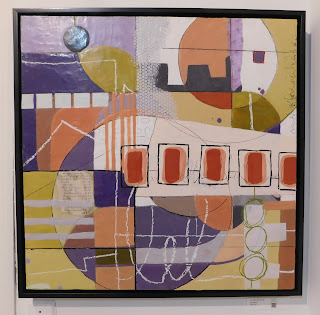Between the Lines: Waxing Coalescent
 |
| State of Mind |
 |
| A New Perspective |
 |
| Paradigm Shift |
 |
| Kind (collaboration with Canton artist Steven Ehret) |
 |
| Bit By Bit |
 |
| Imagine |
By Tom Wachunas
“My belief is that all humans and
every living thing in the universe are connected through an invisible force of
energy, a shared Divine DNA. I set out to capture the rhythm and depth of this
vast connection through my paintings, using colors, shapes, complexity, and
layers with encaustic medium and collage. I then add lines that tie the
paintings together, one to the next. The results…celebrate the inherent Divine
essence present in all things.” -
Therese Cook, from her exhibition artist statement
EXHIBIT: CONNECTIONS:
Encaustic Works by Therese Cook / at Strauss Studios, THROUGH October 11,
2024 [closing artist reception at 6pm on OCTOBER 4] / 236 Walnut Avenue NE,
Canton, OH / Viewing Hours: Mon-Fri 10am to 5pm, Sat. 12noon to 5pm/ 330-456-0300
https://john-strauss-furniture.myshopify.com/
https://www.theresecookart.com/Art/IndexArt.php
en·caus·tic
(in-ˈkȯ-stik) – noun: a paint made from
pigment mixed with melted beeswax and resin and after application fixed by heat
/ also, the method involving the use of encaustic or a work produced by this
method
At one point during the August 31 opening
reception for this show of encaustic
works by Canton’s Therese Cook, viewers were encouraged to participate in a
Q&A session with the artist. One woman asked Cook, “How do you know when a
painting is finished?”
Yikes.
I’m embarrassed to tell you that I don’t recall Cook’s exact answer beyond
hearing that all-important word, intuition. The question, while
certainly understandable and not uncommon - particularly in the context of
making abstract art - stirs me to share a bit of personal philosophy.
I believe
a work of visual art is never “finished” until someone other than the artist
actively looks at it. That’s your/our mission here. And even that moment, that
decision, is not an end, but only a first step in an encounter, a discovering,
of indeterminate duration. It is we, the viewers, who keep art alive and speaking
long after the artist’s actions have ceased. And so perhaps the most enlivening
empirical value of making and looking at art rests in our apprehending the
entire process as a type of collaborative social contract. It’s a connection, a
communication, between artist, source of inspiration, and viewer(s). Call it a
mutually engaging reconciliation of form, content, and meaning.
What, then, is being reconciled in the
savory, tactile abstractions of Therese Cook? Think of her compositions – constructions,
really – as complex, transitory, playful, and dramatic...journeys. Each work
has a structure of sorts, comprised of many diverse
formal elements. On their own, those elements could seem to be haphazard and
randomly scattered on or floating within the picture plane. But it is Cook’s astutely
dynamic distribution of gently luminous, enticing colors that unify, balance
and harmonize them into rhythms, rhymes, and counterpoints that keep your eyes
(and mind) traveling. The repeated configurations of regular and irregular shapes
(geometric and organic) are juxtaposed with embedded patches of words, or variably
textured patterns, with lots of lines looking sometimes like scrawled
signatures, wandering doodles, or the boundaries and borders on sprawling
street maps. These paintings are eloquent metaphorical illustrations, intimating
a spirituality both architectonic and ethereal.
Here, matter and spirit don’t collide. They
coalesce. Symbolically, and with palpable joy. Art with a heartbeat. And how
does Cook account for the energy, the force, the inspiration behind it all? She
had me at “…a shared Divine DNA.”